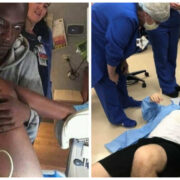Gynaecologist, Emmanuel Anthony Highlights The Risk Of A Vaginal Delivery After Two Caesarean Sections

A wide variety of speculations abound on the possibility and risks of delivering a baby vaginally after having two caesarean sections.
An Obstetrician and Gynaecologist with the Masaka Central Hospital, Karu, has advised women to avoid going through vaginal delivery after giving birth through caesarean section twice.
Dr. Emmanuel Anthony gave the advice in an interview with the News Agency of Nigeria (NAN) on Thursday in Abuja. Anthony noted that women who wished to try vaginal birth after two c-sections were at greater risk of complications and are less likely to succeed.
The medical personnel added that forced vaginal birth could lead to a uterine rupture, where the uterus tears open along the scar line from a previous caesarean delivery. He says:
“A woman whose pelvic and opening is narrow or not well developed is very likely to give birth through caesarean section. Most times, this pelvic and narrow opening could be inherited and has a history in a woman’s family.
“However, it is possible for her to give birth vaginally after two c-sections, but medically we advise them against it as it could lead to heavy bleeding, infection and brain damage to the baby and possibly death.”
Dr. Anthony, however, added that it was possible for a woman who had undergone c-section once to give birth vaginally with her consequent pregnancies. He noted that it was possible if the reason for the first c-section was not repeated in the second pregnancy. He added:
“Every c-section procedure has a reason, which could be due to lack of enough rest on the mother. Fetal distress could also be a reason, where there is no adequate supply of oxygen to the baby.
“When a baby is too big or when the baby is in a breech position, a c-section is often the only option.”
READ ALSO: Ask An Expert: What Are My Chances Of Having A Vaginal Birth After Two Caesarean Sections?
Dr. Anthony, on the other hand, advised women to always attend ante-natal classes to ensure proper monitoring of their health and the baby throughout the period of their pregnancy.


